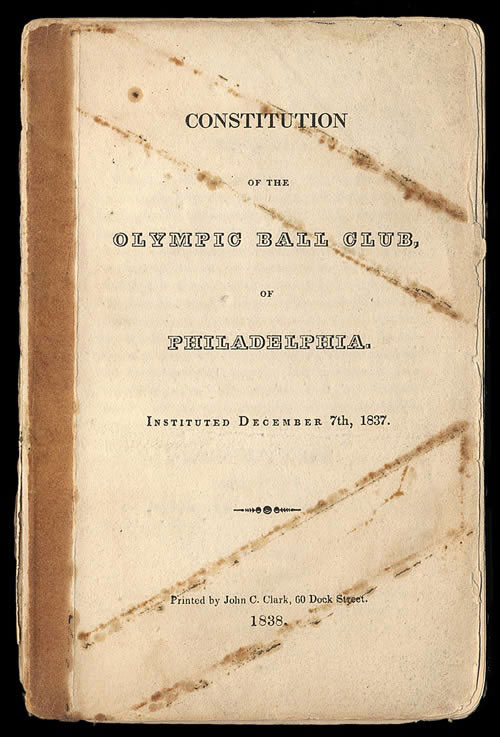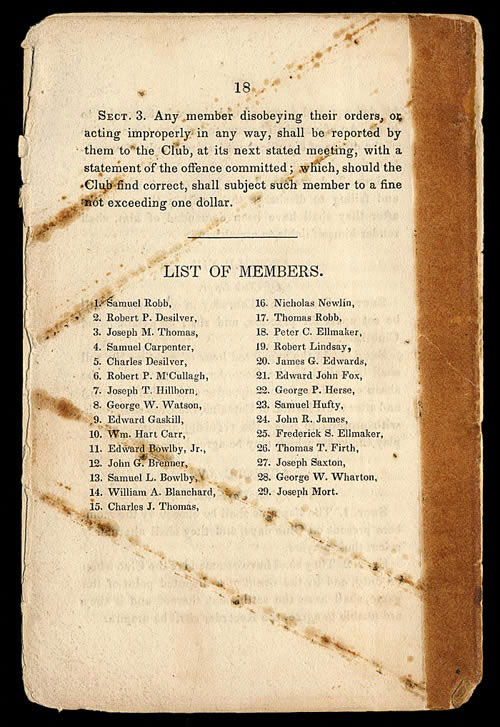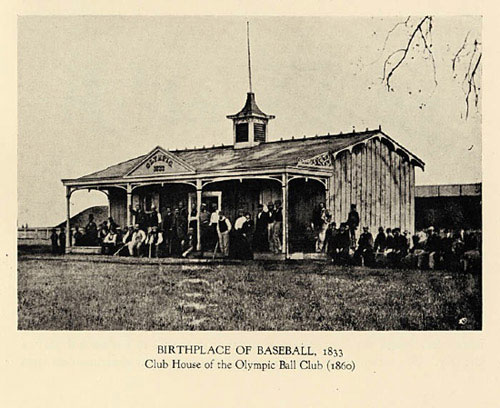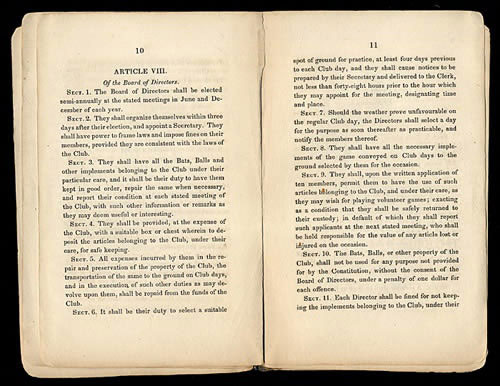Search
The 1838 Olympic Constitution
Sold For:
$141,000
Year: 1838
Auction: 2007 Spring
Lot #: 1
Auction: Pre-1900 Baseball Memorabilia
Presented is the single most significant item that could possibly exist relating to the birth of organized baseball: The first constitution of the Philadelphia Olympic Ball Club, America's first baseball team, dating from 1838. This is the earliest relic of organized baseball from the first organized baseball team in existence. It is arguably the single most historically significant item relating to the origins of the National Pastime in existence. This is the document that records the birth of organized baseball. The Philadelphia Olympics formally established and approved the rules for their club on December 7, 1837. The Olympic constitution detailing these rules was published in 1838 by John C. Clark of 60 Dock Street, Philadelphia. A copy was distributed to each of the twenty-nine team members, all of who were listed by name in the Constitution. This is one of those twenty-nine original Olympic constitutions, issued to one of the original members of the first organized baseball team in the universe. It is the only surviving example known to exist. It is fascinating to note that for many years research libraries have had only an early style photocopy of the 1838 Olympic Constitution. While the photocopies verified its existence and provided a complete record of its contents, the actual whereabouts of the original have long been unknown. Attempts to trace the origins of the photocopy back to the original have always, unfortunately, led to yet another earlier photocopy. The original was seemingly lost to the ages, a mystery ironically befitting a document so integral to the mysterious origins of the National Pastime. It was particularly fascinating for us to note, upon examination and comparison, that the offered Olympic Constitution is the very original from which all Olympic Constitution photocopies were long ago made, and which have been used for reference by scholars and researchers for decades. A PDF of a complete photocopy including all interior pages of the 1838 Olympic Constitution is permanently posted on the Internet site of the Society of American Baseball Research (SABR) and can be found at the following address: http://www.sabr.org/sabr.cfm?a=cms,c,611,34,0 . Comparison of the images of the research photocopy with the offered original will easily verify that this is the long lost original. We have learned from our consignor that he purchased the Olympic Constitution in 1970 from the Brattle Book Shop in Boston, one of America's oldest and most respected antiquarian booksellers (established 1825). The constitution was photocopied prior to 1970. It is a special honor for Robert Edward Auctions to play a role in the rediscovery of a baseball icon of such monumental significance and which has so long been revered by scholars and institutions. We don't believe another Olympic Constitution will ever surface. This document represents the original prime force of organized baseball, the original spark of life, from which the entire world of organized baseball has since evolved. The significance of the Olympic Ball Club of Philadelphia is well documented. The Olympics have long been recognized by historians as being the first organized baseball club, predating the more famous New York Knickerbockers by twelve years. In fact, the long-standing association between baseball and patriotism began with the Philadelphia Olympics. The highlight of the Olympics' season was the Fourth of July celebration. During this celebration, before games, the Declaration of Independence was read by the club President, members sang patriotic songs, and heard "an address delivered for the perpetuation of the Stars and Stripes." This strong early association between baseball and patriotism, which began with the traditions of the Philadelphia Olympics in the 1830s, continues to this day. Prior to 1833, baseball (at this time often referred to as "town-ball") was strictly a children's game. Many believe that Abner Doubleday created baseball in 1839, or that the Knickerbockers "invented" the game in 1845. The date on the cover of the Olympic Constitution at a glance dispels these myths. The true origins of the game predate both of these "events." In 1833 a group of adults first decided to play this children's game in an organized manner. When the Olympics of Philadelphia first organized to play ball in 1833, it was a momentous event as this was the first time ever that adults adapted existing ball games of old to formalized play, and did so despite fear of ridicule from others because they were organizing to play a "children's game." The game was widely known as "town-ball" at this time, but as noted by historian David Block in Baseball Before We Knew It (University of Nebraska Press, 2005), "the term 'town-ball' was simply one of several regional aliases for baseball before 1845." The rules were slightly different than what would develop in the years to come, but the game was clearly baseball. Many people assume that the Knickerbockers were the first baseball team but that distinction belongs to the Philadelphia Olympics. In fact, when the Knickerbockers played their historic first match game on June 19, 1846, they did so against another team, of course. This rival team, known as the New York Base Ball Club, not only existed, but was accomplished enough to beat the Knickerbockers soundly by a score of 23-1. When the Olympics played baseball in the 1830s, there was no other team to play. They were the first and only team in the world, and all of their games were, by necessity, intramural. The significance of the Philadelphia Olympic Club has been recognized since 1833. In fact, throughout the nineteenth century the significance of the Philadelphia Olympic Club was celebrated with a reverence in a manner similar to that of the Knickerbockers. The Philadelphia Olympic Constitution is comprised of eighteen pages plus its original marbled-paper covers. Beginning with the words "Whereas - Field Sports having from time immemorial been the favourite recreation of men...," the Olympic Constitution defines in its preamble and fifteen articles the blueprint of the organization of the first baseball team, the responsibilities of its members and officers, and, in essence, declares baseball to be a game appropriate to be played in a serious and structured manner by adults at the highest level of play. It would be difficult to overstate the historical significance of this development, and the historical importance of the Olympic Constitution. This is quite literally the earliest document relating to organized baseball that could possibly exist. No organized baseball document will ever predate it and none will ever surpass it in significance as a tangible evidence of organized baseball's true and earliest beginnings. Additional information about the Olympic Constitution and an essay about the Philadelphia Olympics by historian John Thorn are presented in Robert Edward Auctions' printed catalog. Dimensions: 5.75 x 3.75 inches. Reserve $50,000. Estimate (open). SOLD FOR $141,000.00
